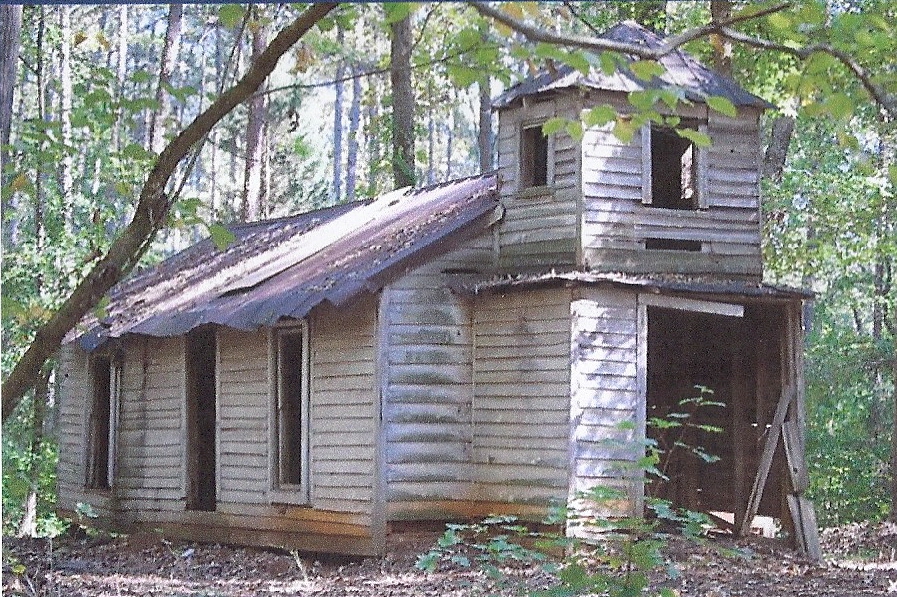Neely School
Two weeks ago I cleaned my desk off and was rewarded by being reminded of something I had lost sight of -- the Neely School which, in October of 2017, became a historic landmark in Rowan County, North Carolina. This is NOT a Rosenwald School. It's something more unusual -- a school built by an African American individual, on his own land, with the intention of educating his family and others in the rural area where he lived. The year was 1908.
Here's an image of the school the way it looked in 2010 when Mary Neely Grissom, granddaughter of Julius and Katie Neely, went walking in the woods, intent on finding the schoolhouse she went to in first, second and third grades. She had not laid eyes on it in sixty five years. In that time Mary had gone to public school and to college at North Carolina Central University. She had moved away from home, settled in Winston-Salem, and for many years, been a French and Spanish teacher. But a recent conversation with a new friend had set her thinking. "Is that little schoolhouse still standing?" the friend had asked, hearing about the special place where Mary had started school. Mary had responded that she did not know.
Neely School was set way back in the woods on farmer Julius Neely's property so it wouldn't attract unwanted attention. In the early years of the twentieth century not everyone agreed about the need to educate "Negroes" or even that blacks and whites were equal partners in public life. Ten years before the schoolhouse opened, not far from where it stood, a major riot shook the city of Wilmington when whites, unnerved by African Americans gains in city government, stormed the office of the black- owned newspaper setting off three days of rioting. 14 African Americans were killed. In August of 1906, in the county where Julius Neely and his family were then living, three African American men were lynched -- dragged from the jail cells where they were awaiting trial, hanged by a mob, their bodies then shot. It was a time of anxiety and fear.
And yet, it was also a time of hope. At his church, Julius Neely was inspired by a sermon he heard from a visiting minister that hugely impressed him. James Aggrey had come to the United States from Ghana. the land where so many African men and women had been captured or sold into slavery, herded into ships and sent to America. Aggrey had come voluntarily, seeking education. At Livingstone College in Salisbury he had studied Greek and Latin. He had gone on to become a minister. And now, at AME Zion church in the little town of China Grove, North Carolina, he was preaching the powerful, liberating effect of education and Julius Neely heard him. Their own parents had been slaves,willfully deprived of any chance for education, but Julius and Katie Neely decided that they would not allow that to happen to their children.
Friends and neighbors pitched in to help with clearing the land, sawing the planks, dragging them into the woods, and raising the simple one room schoolhouse. Julius Neely met with the Superintendent of Schools who said that if he could provide the schoolhouse, the county would send a teacher. And, among the students in the very first class at Neely Schoolhouse, was Julius and Katie's daughter May.
It was over a hundred years later, in 2010, that Mary Neely Grissom, May's niece, Julius and Katie's granddaughter, came looking for the schoolhouse. Life had changed in Rowan County in that time. In the late 1940s the county had opened a public elementary school for African American children and in the decades that followed schools had been integrated. Children went to school as a matter of course. Mary and many of her cousins had moved away for education and for work but the memory of their first schoolhouse had stayed with them and, once they realized it was still standing, they decided it had to be preserved. There were 50 living Neely cousins, all of whom owned a share of their grandfather's property. Led by Mary, they formed the Historic Neely School Foundation, registered it as a non-profit, went after preservation grants and began a campaign of publicity and community fundraising.
On what would have been Julius Neely's 142nd birthday Neely Schoolhouse was raised, transferred to a flatbed truck and moved to a new location on Neelytown Road where it can be seen and appreciated. A county historic plaque identifies it. And, commissioned by the Historic Neely School Foundation, a children's book tells its story. Little School in the Woods by Emily Brewer, illustrated by Maggie Shibley. I couldn't put it down!

